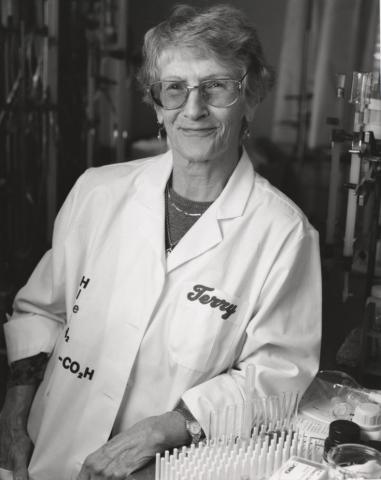NHLBI Alumnus Terry Stadtman Dies

Dr. Thressa “Terry” Stadtman, 96, died Dec. 11 at her home. She was a retired senior investigator and former chief of the section on intermediary metabolism and bioenergetics in NHLBI’s Laboratory of Biochemistry. She made seminal discoveries on the role of vitamin B12 and the physiological functions of selenium and selenocysteine, the latter an amino acid she discovered.
Stadtman was born in Sterling, N.Y., and studied bacteriology at Cornell University, where she received her B.S. in 1940 and her M.S. in 1942. She and her husband Earl Stadtman were one of the first husband-and-wife scientists at NIH, arriving in 1950. She had received her Ph.D. in 1949 at the University of California, Berkeley.
In a career spanning nearly 60 years, Stadtman became known as the “mother of selenium biochemistry.” She retired from NIH in 2009. She was elected to membership in the National Academy of Sciences in 1981 and the American Academy of Arts and Sciences in 1982. Among her many awards were the William C. Rose Award of the American Society of Biological Chemists in 1986; the Klaus Schwarz Medal from the International Association of Bioinorganic Scientists in 1988; and the inaugural L’Oreal Lifetime Achievement Award for Women in Science from L’Oreal-UNESCO in 2000. The organism Methanospaera stadtmaniae is named in her honor.
“Terry is perhaps best known as a superb mentor,” said Dr. Michael Gottesman, NIH deputy director for intramural research. “She and her husband Earl developed a unique way of conducting research and training scientists, which colleagues called ‘the Stadtman way,’ referring not only to the extraordinarily high standard of rigor they set in biochemical research, but also to their generous sharing of credit in publications with more junior scientists.”
After Earl’s death in 2008, Terry deeded 5.8 acres of her property to form an expansion of Rock Creek Regional Park, now known as the Stadtman Preserve.
Stadtman is survived by hundreds of close friends. She did not wish to have a funeral service. A scientific symposium at NIH will be planned for the spring in her honor.
